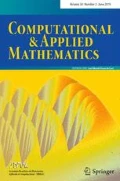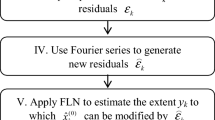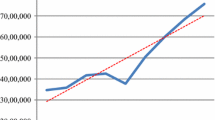Abstract
Tourism demand forecasting plays a significant role in devising tourism development policies for countries. Available data on tourism demand usually consist of a nonlinear real-valued sequence. However, the samples are often derived from uncertain assessments that do not satisfy statistical assumptions. Therefore, we use fuzzy regression analysis with neural networks to generate data intervals consisting of upper and lower wrapping sequences to deal with uncertainty. Then, the best non-fuzzy performance values obtained by these data intervals are applied to optimize grey prediction models without statistical assumptions. The forecasting accuracy of the proposed interval grey prediction models was verified using real data on foreign tourists. The results show that the proposed prediction models are comparable to the other interval grey prediction models considered.


Similar content being viewed by others
References
Assaf AG, Barros CP, Gil-Alana LA (2011) Persistence in the short- and long-term tourist arrivals to Australia. J Travel Res 50(2):213–229
Back AD, Chen T (2002) Universal approximation of multiple nonlinear operators by neural networks. Neural Comput 14:2561–2566
Beneki C, Eeckels B, Leon C (2012) Signal extraction and forecasting of the UK tourism income time series: a singular spectrum analysis approach. J Forecast 31(5):391–400
Cang S (2014) A comparative analysis of three types of tourism demand forecasting models: individual, linear combination and non-linear combination. Int J Tourism Res 16(6):596–607
Chen CI (2008) Application of the novel nonlinear grey Bernoulli model for forecasting unemployment rate. Chaos Solitons Fractals 37(1):278–287
Chen CI, Chen HL, Chen SP (2008) Forecasting of foreign exchange rates of Taiwan’s major trading partners by novel nonlinear grey Bernoulli model NGBM(1,1). Commun Nonlinear Sci Numer Simul 13(6):1194–1204
Chen YY, Liu HT, Hsieh HL (2019) Time series interval forecast using GM(1,1) and NGBM(1, 1) models. Soft Comput 23:1541–1555
Claveria O, Datzira J (2010) Forecasting tourism demand using consumer expectations. Tourism Rev 65(1):18–36
Claveria O, Monte E, Torra S (2015) A new forecasting approach for the hospitality industry. Int J Contemporary Hospit Manag 27(7):1520–1538
Claveria O, Torra S (2014) Forecasting tourism demand to Catalonia: neural networks vs time series models. Econ Model 36:220–228
Cuhadar M, Cogurcu I, Kukrer C (2014) Modelling and forecasting cruise tourism demand to Izmir by different artificial neural network architectures. Int J Business Soc Res 4(3):12–28
Dang Y, Wang Z, Qian W, Xiong P (2016) Grey prediction techniques and methods. Science Press, Beijing
Deng JL (1982) Control problems of grey systems. Syst Control Lett 1(5):288–294
Demšar J (2006) Statistical comparisons of classifiers over multiple data sets. J Mach Learn Res 7:1–30
Habibi F, Rahim KA, Ramchandran S, Chin L (2009) Dynamic model for international tourism demand for Malaysia: panel data evidence. Int Res J Finance Econ 33:207–217
Hsu YT, Liu MC, Yeh J, Hung HF (2009) Forecasting the turning time of stock market based on Markov-Fourier grey model. Expert Syst Appl 36(4):8597–8603
Hu YC (2009) Functional-link nets with genetic-algorithm-based learning for robust nonlinear interval regression analysis. Neurocomputing 72(7-9):1808–1816
Hu YC (2017) Electricity consumption prediction using a neural-network-based grey prediction approach. J Oper Res Soc 68:1259–1264
Hu YC (2020) A multivariate grey prediction model with grey relational analysis for bankruptcy prediction problems. Soft Comput 24:4259–4268
Hu YC, Jiang P, Lee PC (2019) Forecasting tourism demand by incorporating neural networks into Grey-Markov models. J Oper Res Soc 70:12–20
Huang YL, Lin CT (2011) Developing an interval forecasting method to predict undulated demand. Qual Quant 45:513–524
Huang L, Zhang BL, Huang Q (1998) Robust interval regression analysis using neural networks. Fuzzy Sets Syst 97:337–347
Iman RL, Davenport JM (1980) Approximations of the critical region of the Friedman statistic. Commun Stat 96:571–595
Ishibuchi H, Tanaka H (1992) Fuzzy regression analysis using neural networks. Fuzzy Sets Syst 50:257–265
Jeng JT, Chuang CC, Su SF (2003) Support vector interval regression networks for interval regression analysis. Fuzzy Sets Syst 138:283–300
Kim JH, Wong K, Athanasopoulos G, Liu S (2011) Beyond point forecasting: evaluation of alternative prediction intervals for tourist arrivals. Int J Forecast 27:887–901
Lee SC, Shih LH (2011) Forecasting of electricity costs based on an enhanced gray-based learning model: a case study of renewable energy in Taiwan. Technol Forecast Soc Change 78:1242–1253
Lee YS, Tong LI (2011) Forecasting energy consumption using a grey model improved by incorporating genetic programming. Energy Convers Manage 52:147–152
Li G, Song H, Cao Z, Wu DC (2013) How competitive is Hong Kong against its competitors? An econometric study. Tourism Manag 36(1):247–256
Lin CJ, Chen HF, Lee TS (2011) Forecasting tourism demand using time series, artificial neural networks and multivariate adaptive regression splines: evidence from Taiwan. Int J Business Admin 2(2):14–24
Liu S, Lin Y (2010) Grey information: theory and practical applications. Springer, London
Liu S, Yang Y, Forrest J (2017) Grey data analysis: methods, models and applications. Springer, Berlin
Liu S, Zeng B, Liu J, Xie N, Yang Y (2015) Four basic models of GM(1, 1) and their suitable sequences. Grey Syst Theory Appl 5:141–156
Lu J, Xie W, Zhou H, Zhang A (2016) An optimized nonlinear grey Bernoulli model and its applications. Neurocomputing 177:206–214
Onafowora OA, Owoye O (2012) Modelling international tourism demand for the Caribbean. Tourism Econ 18(1):159–180
Ouerfelli C (2008) Co-integration analysis of quarterly European tourism demand in Tunisia. Tourism Manag 29:127–137
Makridakis S (1993) Accuracy measures: theoretical and practical concerns. Int J Forecast 9(4):527–529
Ma X, Liu Z, Wang Y (2019) Application of a novel nonlinear multivariate grey Bernoulli model to predict the tourist income of China. J Comput Appl Math 347:84–94
Shih CS, Hsu YT, Yeh J, Lee YP (2011) Grey number prediction using the grey modification model with progression technique. Appl Math Model 35(3):1314–1321
Song H, Gartner WC, Tasci ADA (2012) Visa restrictions and their adverse economic and marketing implications–evidence from China. Tourism Manag 33(2):397–412
Song H, Qiu RTR, Park J (2019) A review of research on tourism demand forecasting: launching the annals of tourism research curated collection on tourism demand forecasting. Ann Tourism Res 75:338–362
Suganthi L, Samuel AA (2012) Energy models for demand forecasting-a review. Renew Sustain Energy Rev 16:1223–1240
Sun X, Sun W, Wang J, Gao Y (2016) Using a Grey-Markov model optimized by Cuckoo search algorithm to forecast the annual foreign tourist arrivals to China. Tourism Manag 52:369–379
Tanaka H (1987) Fuzzy data analysis by possibilistic linear models. Fuzzy Sets Syst 24:363–375
Tanaka H, Uejima S, Asai K (1982) Linear regression analysis with fuzzy model. IEEE Trans Syst Man Cybern 12:903–907
Tsui WHK, Balli HO, Gilbey A, Gow H (2014) Forecasting of Hong Kong airport’s passenger throughput. Tourism Manag 42:62–76
Van Leekwijck W, Kerre EE (1999) Defuzzification: criteria and classification. Fuzzy Sets Syst 108:159–178
Wang ZZ, Dang YG, Liu SF, Zhao JJ (2009) Solution of GM (1, 1) power model and its properties. Syst Eng Electron 31:2380–2383
Wang ZX, Hipel KW, Wang Q, He SW (2011) An optimized NGBM(1,1) model for forecasting the qualified discharge rate of industrial wastewater in China. Appl Math Model 35:5524–5532
Wang CH, Hsu LC (2008) Using genetic algorithms grey theory to forecast high technology industrial output. Appl Math Comput 195:256–263
Wang ZX, Li Q, Pei LL (2018) A seasonal GM(1,1) model for forecasting the electricity consumption of the primary economic sectors. Energy 154:522–534
Wu W, Ma X, Zeng B, Wang Y, Cai W (2019) Forecasting short-term renewable energy consumption of China using a novel fractional nonlinear grey Bernoulli model. Renew Energy 140:70–87
Wu DC, Song H, Shen S (2017) New developments in tourism and hotel demand modeling and forecasting. Int J Contemporary Hospit Manag 29(1):507–529
Wu L, Liu S, Fang Z, Xu H (2015) Properties of the GM(1,1) with fractional order accumulation. Appl Math Comput 252:287–293
Xie N, Liu S, Yuan C, Yang Y (2014) Grey number sequence forecasting approach for interval analysis: a case of China’s gross domestic product prediction. J Grey Syst 26(1):45–58
Xie M, Wu L, Li B, Li Z (2020) A novel hybrid multivariate nonlinear grey model for forecasting the traffic-related emissions. Appl Math Model 77:1242–1254
Yu G, Schwartz Z (2006) Forecasting short time-series tourism demand with artificial intelligence models. J Travel Res 45:194–203
Zeng B, Liu SF, Xie NM, Cui J (2010) Prediction model for interval grey number based on grey band and grey layer. Control Decision 25(10):1585–1592
Zeng B, Li C, Zhou XY, Long XJ (2014) Prediction model of interval grey number with a real parameter and its application. Abstr Appl Anal. https://doi.org/10.1155/2014/939404
Acknowledgements
The authors would like to thank the anonymous referees for their valuable comments. This research is supported by the Ministry of Science and Technology, Taiwan under Grant MOST 108-2410-H-033-038-MY2.
Author information
Authors and Affiliations
Corresponding author
Ethics declarations
Conflict of interest
The authors declare that they have no conflict of interest.
Studies with human participants
This article does not contain any studies with human participants performed by the authors.
Additional information
Communicated by Marcos Eduardo Valle.
Publisher's Note
Springer Nature remains neutral with regard to jurisdictional claims in published maps and institutional affiliations.
Rights and permissions
About this article
Cite this article
Hu, YC., Jiang, P. Fuzzified grey prediction models using neural networks for tourism demand forecasting. Comp. Appl. Math. 39, 145 (2020). https://doi.org/10.1007/s40314-020-01188-6
Received:
Revised:
Accepted:
Published:
DOI: https://doi.org/10.1007/s40314-020-01188-6




